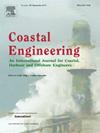海浪在大规模沿海复合洪水中的重要性:以佛罗伦萨飓风为例(2018年)
IF 4.2
2区 工程技术
Q1 ENGINEERING, CIVIL
引用次数: 0
摘要
尽管波浪驱动的洪水对沿海洪水灾害有重大贡献,但在大规模洪水灾害评估和早期预警系统中,波浪驱动的洪水往往被忽视或以近似的方式包括在内。本文介绍了一种将入射波和次重力波过程纳入快速复合洪水模型的方法,该方法通过对SFINCS软件进行扩展,并使用SnapWave平稳波能量求解器。这种扩展有效地将近海入射波和次重力波条件转换为近岸,从而可以估计入射波引起的设置,并解决波浪上升和过顶问题。采用四叉树方法优化海岸带波浪过程的网格分辨率。该方法在美国北卡罗来纳州和南卡罗来纳州海岸线沿线的佛罗伦萨飓风(2018年)中得到了验证,在那里观测到的近海浪高达到10米。结果表明,由于海浪的影响,飓风的影响范围超出了登陆区域数百公里,突出了它作为沿海洪水驱动因素的重要性。在19%的海岸线分析中,波浪的贡献超过了所有其他洪水驱动因素的总和,波浪对额外洪水面积的贡献为226平方公里,洪水量为6200万立方米。研究还表明,包括波浪诱导设置在内的更简单的参数化方法可能导致模拟水深的显著差异。扩展的SFINCS模型的计算效率允许在有限的计算资源下模拟1000公里的海岸线。由此可见,波浪效应在沿海复合洪涝灾害评价中的重要作用。本文章由计算机程序翻译,如有差异,请以英文原文为准。
The importance of waves in large-scale coastal compound flooding: A case study of Hurricane Florence (2018)
Wave-driven flooding is often neglected or included in an approximate way in large-scale flood hazard assessments and early warning systems, despite its significant contribution to coastal flood hazards. This study introduces a method to incorporate incident and infragravity wave processes into a fast compound flood model by extending the SFINCS software with the SnapWave stationary wave energy solver. This extension efficiently translates offshore incident and infragravity wave conditions to the nearshore, allowing for the estimation of incident-wave-induced setup and the resolution of wave runup and overtopping. A quadtree approach is employed to optimize the grid resolution for wave processes in the coastal zone.
The approach is validated for Hurricane Florence (2018) along the North and South Carolina coastline of the United States, where observed offshore wave heights reached 10 m. The results illustrate that the impact of the hurricane extended hundreds of kilometers beyond the landfall area due to waves, highlighting its importance as coastal flood driver. In 19% of the coastline analyzed, wave contributions surpassed all other flood drivers combined, with waves contributing to an additional flooded area of 226 km2 and a flood volume of 62 million m3.
The study also indicates that simpler parameterized methods for including wave-induced setup can lead to significant discrepancies in modeled water depths. The computational efficiency of the extended SFINCS model allows for the simulation of 1,000 km of coastline with limited computational resources. Hereby the critical role of wave effects in coastal compound flood hazard assessments could be demonstrated.
求助全文
通过发布文献求助,成功后即可免费获取论文全文。
去求助
来源期刊

Coastal Engineering
工程技术-工程:大洋
CiteScore
9.20
自引率
13.60%
发文量
0
审稿时长
3.5 months
期刊介绍:
Coastal Engineering is an international medium for coastal engineers and scientists. Combining practical applications with modern technological and scientific approaches, such as mathematical and numerical modelling, laboratory and field observations and experiments, it publishes fundamental studies as well as case studies on the following aspects of coastal, harbour and offshore engineering: waves, currents and sediment transport; coastal, estuarine and offshore morphology; technical and functional design of coastal and harbour structures; morphological and environmental impact of coastal, harbour and offshore structures.
 求助内容:
求助内容: 应助结果提醒方式:
应助结果提醒方式:


